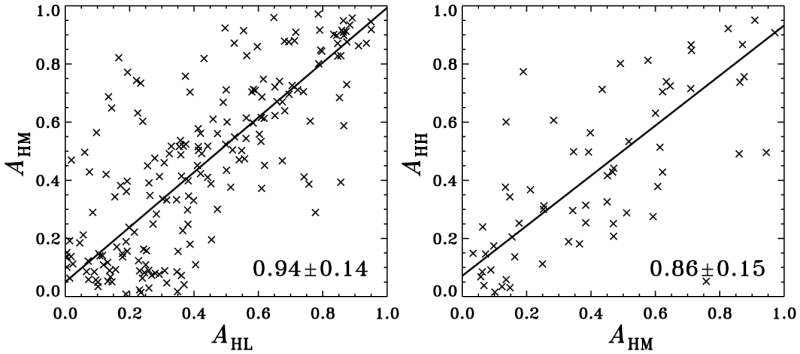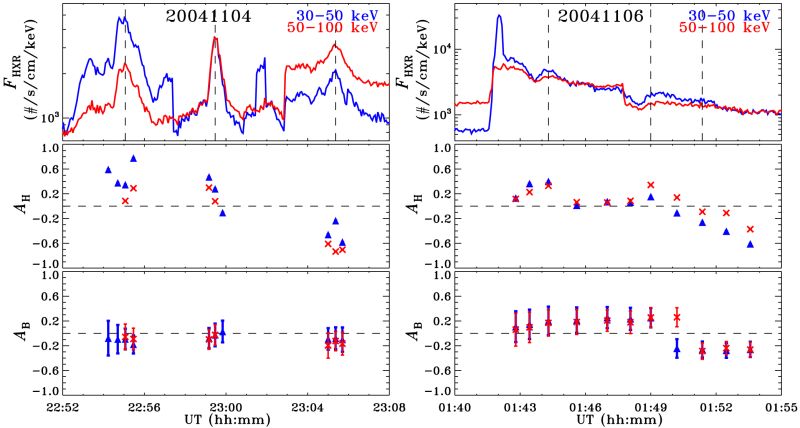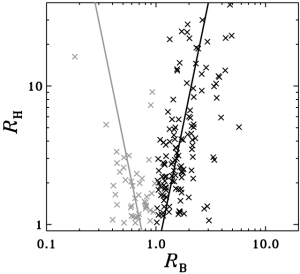Hard X-ray Footpoint Asymmetry: Difference between revisions
imported>Hhudson No edit summary |
imported>Schriste No edit summary |
||
| Line 1: | Line 1: | ||
{{Infobox Nugget | {{Infobox Nugget | ||
|name = Nugget | |name = Nugget | ||
|number = 212 | |||
|title = Hard X-ray Footpoint Asymmetry | |title = Hard X-ray Footpoint Asymmetry | ||
|first_author = Ya-Hui YANG | |first_author = Ya-Hui YANG | ||
|second_author = | |second_author = | ||
|publish_date = November 7, 2013 | |publish_date = November 7, 2013 | ||
| | |next_nugget={{#ask: [[Category:Nugget]] [[RHESSI Nugget Index::213]]}} | ||
| | |previous_nugget={{#ask: [[Category:Nugget]] [[RHESSI Nugget Index::211]]}} | ||
}} | }} | ||
Latest revision as of 17:37, 22 August 2018
| Nugget | |
|---|---|
| Number: | 212 |
| 1st Author: | Ya-Hui YANG |
| 2nd Author: | |
| Published: | November 7, 2013 |
| Next Nugget: | The 1859 Space Weather Event Revisited |
| Previous Nugget: | The Halloween Flares and Large-Scale Correlations |
Introduction
Solar flares involve coronal magnetic structures (loops) rooted in the dense lower atmosphere. Accordingly the appearance of bipolar features, reflecting the magnetic linking of regions of opposite polarity, seems very reasonable.
The chromospheric double hard X-ray (HXR) sources generally appear at the conjugate footpoints of flaring loops, but with asymmetric flux distributions. One footpoint typically is brighter than the other. Such asymmetries could be associated with the process of particle acceleration in the corona, the transport process from the corona to the chromosphere, or the precipitation process into the chromosphere depending on the magnetic field configurations and plasma conditions of the flaring loops. The HXR footpoint asymmetry is observed to vary with time and even to reverse itself during a flare. The statistical study of Yohkoh flares shows that the HXR footpoints display almost the same asymmetry behavior in the low and medium Yohkoh/HXT energy channels [Ref. 1], and a earlier 2006 Nugget has already noted interesting features of the RHESSI view of this phenomenon.
On the other hand, the relationship between the chromospheric HXR fluxes and the photospheric magnetic field strengths has been investigated extensively in previous studies, but no particular preference of magnetic field region was found for the bright HXR footpoint. We attempt to address the energy dependence of HXR footpoint emissions, determine their relationship to the photospheric magnetic fields beneath, and discuss the causes of asymmetry reversal based on the RHESSI HXR observations during 2002-2009 and the corresponding pre-flare MDI magnetograms [Ref. 2].
Data Analysis
Energy dependence of asymmetry: We use the parameter AH, as introduced by Alexander & Metcalf [Ref. 3], to quantify the HXR footpoint asymmetry: AH = (I2 - I1)/(I2 + I1). The wide distribution of AH in Figure 1 implies that the HXR footpoints could have different asymmetric behaviors in different energies, although there is no significant energy dependence of footpoint asymmetry in our statistical results. A feature of asymmetry reversal between different energy ranges is indeed observed in some of our studied events.

Relation with magnetic field: We also estimate the HXR flux ratio between the two conjugate footpoints and compare it with the inverse ratio of corresponding magnetic field strengths on the photosphere. It is found in Figure 2 that the stronger HXR footpoint preferentially appears at the region with the weaker magnetic field strength. Moreover, the HXR footpoint fluxes become more asymmetric when the footpoints move to the areas with more asymmetric field strengths.
Causes of asymmetry reversal: Two events, the 2004 November 4 M5.4 flare and the 2004 November 6 M3.6 flare, are shown in Figure 3 to illustrate two different scenarios causing sign changes in AH during flaring periods. By comparing the estimated asymmetry quantities with the HXR lightcurves, the asymmetry reversal in the late period of M5.4 flare is mainly attributed to the difference of coronal energy release or acceleration processes in different periods, while it is associated with the location changes of HXR footpoints moving to different magnetic field regions in the M3.6 flare.

Conclusions
Our statistical results show that 75% of the strong HXR footpoints coincide with the weaker magnetic field strengths, which is qualitatively consistent with the prediction of an asymmetric magnetic mirror scenario. Even so, it must be emphasized that the properties of HXR footpoint asymmetry are also affected by other transport effects and coronal acceleration process besides the asymmetric magnetic mirror. It is difficult to attribute the footpoint asymmetry purely to a single effect for solar flares. It would be worthwhile to investigate further the causes of footpoint asymmetry reversal during different flaring periods or between different energy ranges.
References
[1] "Energy dependence of electron trapping in a solar flare"
[2] "Asymmetry of Hard X-Ray Emissions at Conjugate Footpoints in Solar Flares"
